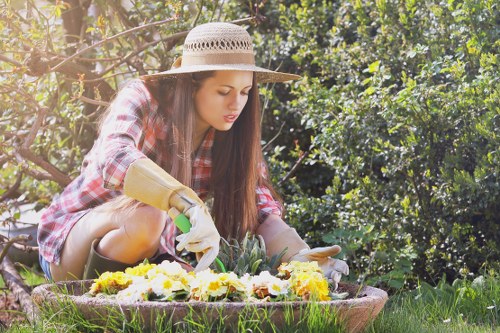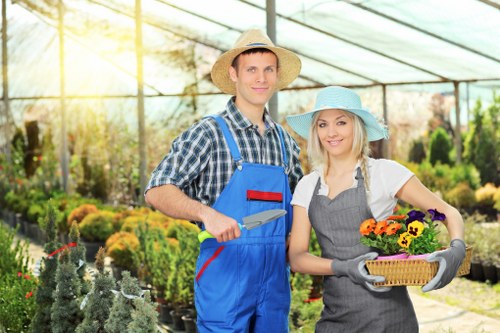Gardener Stamford Hill: Nurturing Green Spaces in the Heart of London

Stamford Hill, located in the vibrant borough of Hackney, London, is not just known for its rich cultural heritage and colorful community but also for its lush green spaces. A Gardener in Stamford Hill plays a pivotal role in maintaining and enhancing these areas, ensuring that the neighborhood remains a serene and beautiful place to live.
Gardening in Stamford Hill is more than just a hobby; it's a passion that brings together residents, local businesses, and community centers to create and sustain green environments. Whether it's through public parks, private gardens, or community plots, gardeners here are dedicated to fostering a sense of community and environmental stewardship.
In this article, we'll explore the essential aspects of being a gardener in Stamford Hill, the impact they have on the community, and the unique features that make gardening in this area both challenging and rewarding.
The Role of a Gardener in Stamford Hill

A gardener in Stamford Hill is responsible for a variety of tasks that ensure the well-being of plants and the overall aesthetics of green spaces. Their duties include planting, pruning, weeding, and maintaining garden structures such as fences, sheds, and patios.
Moreover, gardeners in this area often collaborate with local schools and organizations to promote environmental education. They may lead workshops on sustainable gardening practices, teach children about plant biology, and engage the community in beautification projects.
Additionally, they play a crucial role in pest and disease management, ensuring that gardens remain healthy and free from invasive species that could disrupt the local ecosystem.
Essential Skills and Qualifications

Becoming a successful gardener in Stamford Hill requires a blend of technical skills and personal attributes. Knowledge of horticulture, plant biology, and soil science is fundamental. Gardeners must understand the specific needs of various plants, including sunlight, water, and nutrient requirements.
Physical stamina is also important, as gardening often involves bending, lifting, and working outdoors for extended periods. Attention to detail ensures that gardens are well-maintained and aesthetically pleasing.
Furthermore, good communication skills are essential for collaborating with clients, community members, and other stakeholders. A passion for nature and a commitment to sustainability drive gardeners to create eco-friendly and thriving green spaces.
Tools and Equipment

A gardener in Stamford Hill utilizes a variety of tools and equipment to perform their duties efficiently. Basic tools include shovels, rakes, hoes, and pruners. For more specialized tasks, they may use wheelbarrows, hedge trimmers, and irrigation systems.
In addition to hand tools, power equipment like lawnmowers, tillers, and leaf blowers are essential for maintaining larger green spaces. Sustainable gardeners also incorporate eco-friendly tools, such as electric or battery-powered equipment, to reduce their carbon footprint.
Proper maintenance of tools is crucial to ensure their longevity and effectiveness. Regular cleaning, sharpening, and storage help gardeners keep their equipment in top condition, ready for the demands of their work.
Seasonal Gardening in Stamford Hill

Gardening in Stamford Hill varies with the seasons, each bringing its own set of tasks and opportunities. In spring, gardeners focus on planting new flowers and vegetables, as well as preparing the soil for growth.
Summer requires diligent watering, weeding, and pest control to support healthy plant development. During this time, gardeners may also engage in pruning to maintain the shape and health of plants.
Autumn involves harvesting mature crops and preparing gardens for the winter months. Gardeners may plant cover crops to enrich the soil and protect it from erosion.
In winter, the focus shifts to maintenance tasks such as repairing garden structures, planning for the upcoming year, and protecting plants from frost and harsh weather conditions.
Community Impact and Benefits
A gardener in Stamford Hill significantly contributes to the community's well-being. Well-maintained green spaces provide residents with a place to relax, socialize, and engage in recreational activities.
Gardens also have environmental benefits, such as improving air quality, reducing urban heat islands, and supporting local wildlife. By cultivating diverse plant species, gardeners promote biodiversity and create habitats for pollinators like bees and butterflies.
Furthermore, community gardening projects can foster social connections, bringing together people from different backgrounds to work towards a common goal. This sense of unity and collaboration strengthens the community fabric and enhances the quality of life for all residents.
Sustainable Gardening Practices
In Stamford Hill, sustainability is a key focus for gardeners. Implementing eco-friendly practices helps minimize the environmental impact of gardening activities and promotes long-term ecological health.
Some sustainable techniques include composting organic waste to enrich soil, using rainwater harvesting systems for irrigation, and selecting native plant species that are well-adapted to the local climate and require less maintenance.
Additionally, gardeners may incorporate permaculture principles, which emphasize the design of self-sustaining ecosystems. By integrating plants, animals, and natural processes, permaculture aims to create resilient and productive gardens that support both human and environmental needs.
Challenges Faced by Gardeners in Stamford Hill
While gardening in Stamford Hill is rewarding, it comes with its set of challenges. Urban environments often have limited space, making efficient use of available areas crucial.
Soil quality can also be a concern, as urban soils may be compacted or contaminated. Gardeners must take measures to improve soil health, such as adding organic matter and conducting soil tests to determine nutrient levels.
Additionally, managing pests and diseases in a densely populated area requires vigilance and proactive strategies to prevent infestations from spreading.
Gardening Trends in Stamford Hill
Stamford Hill gardeners are embracing modern trends that promote sustainability and innovation. Urban farming is gaining popularity, with rooftop gardens and vertical planting systems becoming common solutions to space constraints.
There is also a growing interest in edible gardens, where residents grow their own vegetables and herbs, contributing to food security and reducing reliance on commercial produce.
Furthermore, gardeners are incorporating technology into their practices, using smart irrigation systems, soil sensors, and gardening apps to optimize plant care and resource management.
Local Flora and Fauna
Understanding the local flora and fauna is essential for gardeners in Stamford Hill. The area is home to a variety of plant species, both native and exotic, each with unique requirements and benefits.
Native plants, such as the English oak and foxglove, are well-suited to the local climate and support local wildlife. Exotic plants, on the other hand, add diversity and visual interest to gardens but may require more specialized care.
Fauna, including birds, insects, and small mammals, play a vital role in maintaining the ecological balance of gardens. Gardeners must create habitats that support these creatures, promoting a healthy and vibrant ecosystem.
Top Nearby Areas for Gardening Enthusiasts
- South Tottenham: Just northwest of Stamford Hill, South Tottenham offers expansive parks and community gardens.
- Canonbury: Known for its charming residential gardens and boutique nurseries.
- Palmerston: Features beautiful green spaces and botanical gardens.
- Stroud Green: Home to several community-led gardening projects.
- East Finchley: Offers a mix of public parks and private garden opportunities.
- Finsbury Park: A short distance away, perfect for larger gardening initiatives.
- King's Cross: Emerging with new green spaces and urban gardening trends.
- Hornsey: Known for its lush gardens and green initiatives.
- Southgate: Offers extensive community gardens and green areas.
- Upper Edmonton Features both public and private horticultural projects.
- Highgate: Renowned for its historical gardens and plant diversity.
- Tottenham Hale: Emerging with innovative urban gardening solutions.
- Wood Green: Combines commercial spaces with beautiful green areas.
- Clissold: Offers picturesque gardens and recreational green spaces.
- Archway: Known for its well-maintained public gardens and parks.
Future of Gardening in Stamford Hill
The future looks bright for gardening in Stamford Hill. With increasing awareness of environmental issues and the benefits of green spaces, more residents are becoming involved in gardening activities.
Innovative practices, such as vertical gardening and hydroponics, are being adopted to maximize space and resources. These methods allow gardeners to cultivate more plants in limited areas, contributing to the overall greenery of the neighborhood.
Moreover, community-led initiatives and local government support are driving the development of new green spaces and the enhancement of existing ones. This collaboration ensures that gardening remains a sustainable and integral part of Stamford Hill's identity.
As technology continues to advance, gardeners will have access to new tools and resources that make gardening more efficient and enjoyable. From smart irrigation systems to gardening apps, these innovations will support gardeners in creating thriving, eco-friendly environments.
Getting Involved: How You Can Support Local Gardeners
Supporting local gardeners in Stamford Hill is a great way to contribute to the community and the environment. Here are some ways you can get involved:
- Volunteer: Join local gardening projects or community gardens to lend a hand and share your expertise.
- Donate: Provide financial support or donate gardening supplies to help maintain and expand green spaces.
- Participate: Attend workshops and events organized by local gardeners to learn more about sustainable practices.
- Advocate: Promote the importance of green spaces in your community and support initiatives that protect and enhance them.
- Adopt: Take care of a garden plot or specific plants, contributing to the overall beauty and health of the area.
Conclusion
A gardener in Stamford Hill plays a vital role in shaping the community's green landscape. Through dedication, expertise, and a passion for nature, they create and maintain beautiful spaces that benefit everyone. Whether it's a private garden, a public park, or a community plot, the efforts of local gardeners ensure that Stamford Hill remains a flourishing and vibrant neighborhood.
As we look to the future, continued support and involvement in gardening initiatives will be essential for sustaining and expanding the green spaces that make Stamford Hill a special place to live. Embracing sustainable practices and innovative gardening techniques will help preserve the environment and enhance the quality of life for all residents.
Ultimately, the work of gardeners in Stamford Hill exemplifies the positive impact that dedicated individuals can have on their community and the natural world.
Frequently Asked Questions
1. How can I become a gardener in Stamford Hill?
To become a gardener in Stamford Hill, you can start by gaining relevant experience through gardening courses or apprenticeships. Joining local gardening groups and volunteering at community gardens can also provide valuable skills and connections.
2. What are the best plants to grow in Stamford Hill's climate?
Stamford Hill's climate is suitable for a variety of plants, including native species like English oak and foxglove. Additionally, vegetables such as tomatoes, lettuce, and herbs thrive in this area. It's important to choose plants that are well-adapted to the local conditions for successful growth.
3. How can I support local gardeners in Stamford Hill?
You can support local gardeners by volunteering your time, donating supplies, participating in community gardening events, and advocating for the preservation and expansion of green spaces in the area.
4. What sustainable gardening practices are recommended in Stamford Hill?
Sustainable practices include composting organic waste, using rainwater harvesting systems, planting native species, and implementing permaculture principles. These methods help reduce environmental impact and promote long-term ecological health.
5. Are there community gardens available in Stamford Hill?
Yes, Stamford Hill has several community gardens where residents can grow their own plants, vegetables, and flowers. These gardens provide a space for individuals to connect with nature and each other while contributing to the neighborhood's greenery.